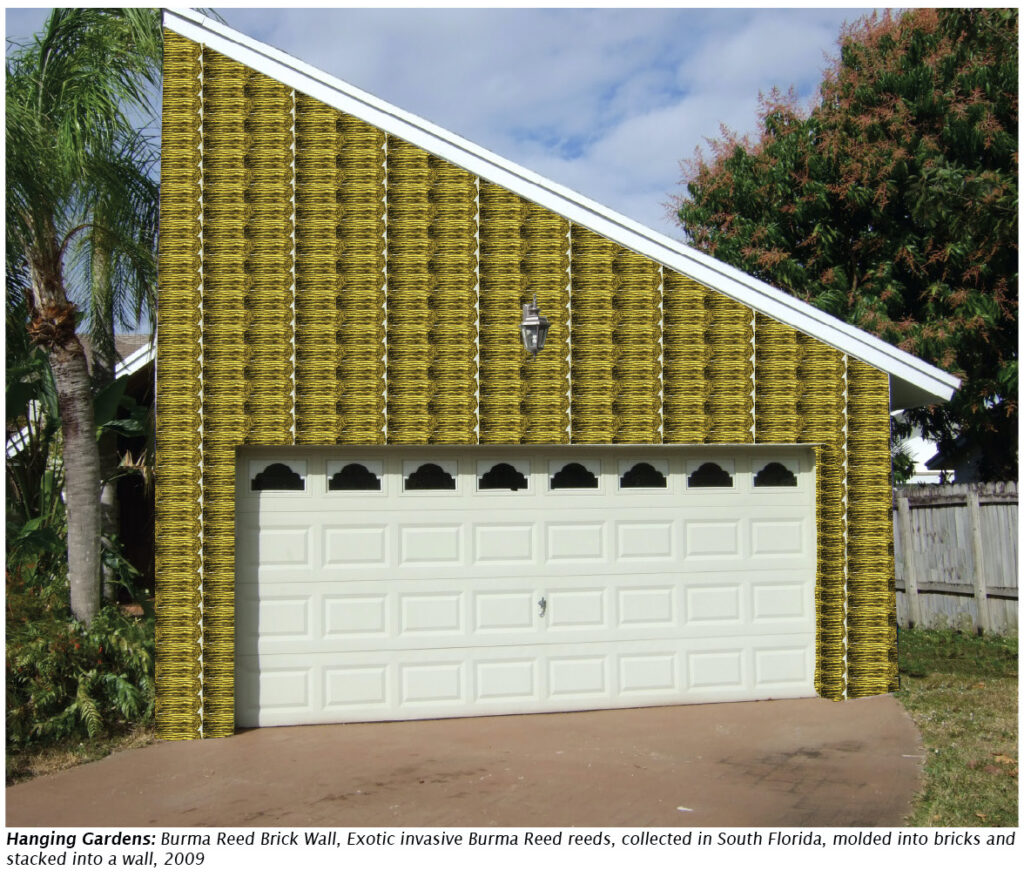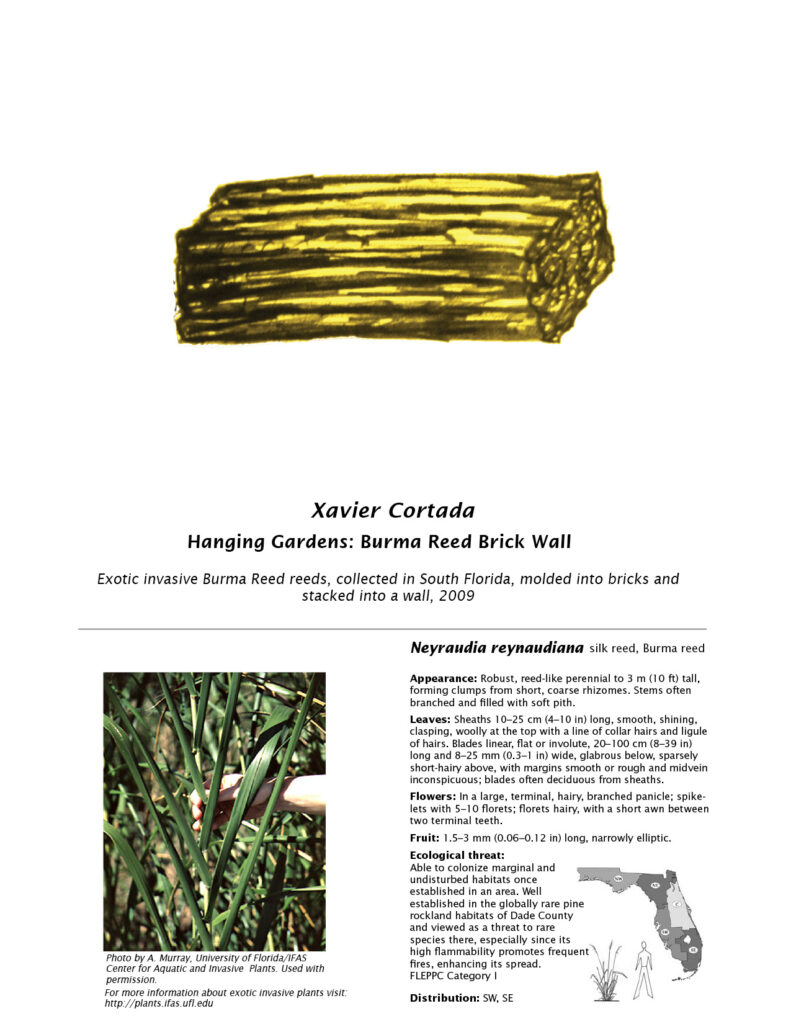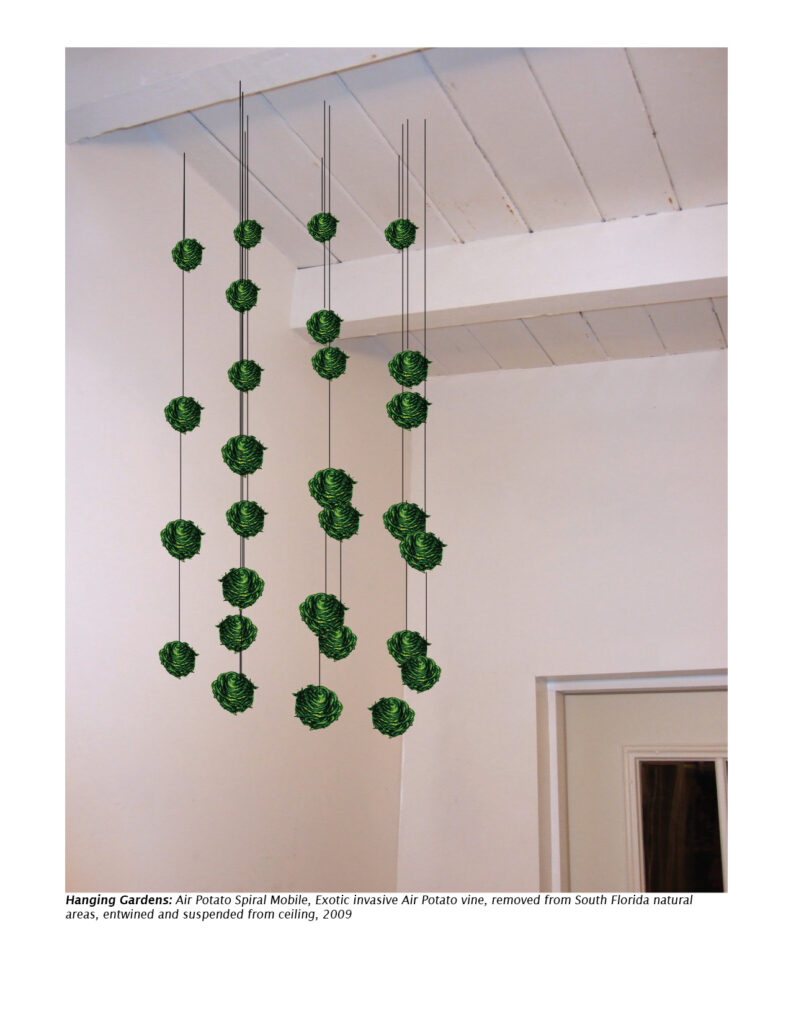
About the Exhibit
Hanging Gardens will be exhibited during Spring 2011 at Miami-Dade Public Library System’s main gallery:
Main Library1st floor exhibition space 101 West Flagler StreetMiami, FL305-375-2665
The Miami-Dade Public Library System’s Art Services and Exhibitions Department curates a year-round program of exhibitions, performances, lectures, panel discussions, and community art projects. All of these are free and open to the public.
The Library also maintain a special collection of over 2,200 works of art. The collection includes works on paper, photographs, artists’ books, and small sculptures, with a focus on African American, Latino, and Miami artists. Additionally, the Vasari Project is an archive that documents the development of the visual arts in Miami-Dade County since 1945. It contains correspondence, press clippings, photographs, oral histories and other materials. The public may access both of these collections for research and reference.
For more information, contact Art Services at 305-375-5048 or art@mdpls.org, and contact the Vasari Project at 305-375-1550 or vasari@mdpls.org
Original Exhibit Proposal
March 10, 2009
Exhibition Proposals
Art Services and Exhibitions
Miami Dade Public Library System
101 W. Flagler Street
Miami, FL 33130
RE: Xavier Cortada: Hanging Gardens
“Hanging Gardens” is a participatory eco-art project to engage residents in the creation of installations in their homes using exotic invasive plants removed from our local ecosystems.
Dear Exhibitions Committee:
Eco-artists work with scientists to develop ways of engaging communities in bioremediation. In developing eco-art, my focus has been to engage residents in urban and coastal reforestation[1] through The Reclamation Project (see: www.reclamationproject.net).
The natural world is truly an interconnected one. Sometimes, rebuilding healthy ecosystems requires not just replacing the native species humans removed, but also eliminating the dangerous ones humans introduced.[2]
I would like to prose “Hanging Gardens,” a series of indoor eco-art installations that address the problem of exotic invasive species destroying South Florida’s ecosystems. Attached please find HangingGarden_CORTADA.pdf.
I aim to create vertical gardens inside the library comprised not of species we want to grow[3], but of trees we want to kill. The installations would be a series of five “hanging” gardens, each created using plant matter (e.g.: cut branches, vines, bark, cones) from a different exotic invasive tree cut down and removed from the local environment.[4]
Prior to the opening of the Hanging Gardens exhibit, I would lead a series of workshops/performances where I would work with volunteers to remove exotic invasive species from the community and use the plant matter as the material/medium for the installation. This process would be documented and included in the exhibit.
The Hanging Gardens exhibit would be accompanied by an educational program developed in tandem with local environmental managers and include a panel discussion and film series showcasing how other eco-art projects across the country have engaged citizens in bioremediation.
Serving as public hanging[5] gardens, the installations at the library would enlist local residents in re-creating them at home. Making commodities out of plants and trees too costly for the state to remove, the eco-art project would encourage residents to seek, cut down and remove the vegetation themselves.
Showcasing their work, these participants would then encourage their neighbors and friends to also “un-grow” plant species that threaten the their local ecosystem as vertical gardens in their homes. Indeed, through Hanging Gardens I want to encourage today’s city dwellers to go on a new kind of wilderness safari[6]. I want them to go out in droves and seek, cut down and remove the invasive exotic vegetation from their local environment and mount them as trophies indoors.
Through this participatory eco-art effort, we can begin to work as a community to mitigate against the damage we brought upon ourselves and help rebuild our local ecosystems.
Sincerely,
Xavier Cortada
[1] The Precursor: Reforesting the Native Species through The Reclamation Project
In 2004, I began creating installations of mangrove seedlings in plastic cups in urban locations where mangrove forests once stood. These vertical nurseries reminded viewers what their community looked like before the concrete was poured.
Since then, The Reclamation Project has created vertical gardens in dozens of public spaces across several Florida cities: Local volunteers have collected and nurtured thousands of seedlings in the water-filled cups until they were large enough to be planted along coastal areas, helping rebuild the ecosystem above and below the waterline.
Inspired by what they saw, many viewers recreated these social sculptures in their private spaces. Growing home-based and school-based mangrove nurseries, participants engaged in bioremediation at the personal level and explored their connection to the natural world.
[2] Brazilian Peppers surrounding Mangroves:
Last year, while doing fieldwork with a mangrove researcher in a remote location in the middle of the Florida Everglades, we stumbled upon a sea of Brazilian Peppers along the fringes of the mangrove forests. There, I arrived at the idea that developing community-driven processes to remove exotic invasive species could be as productive as reforesting the native species they would eventually out-compete and replace.
[3] Vertical Gardens in Concrete Jungles:
Seeking to green concrete jungles, society has developed vertical gardens in urban spaces. Innovative greening can help address global climate change and, if done right, can increase biodiversity. To become true catalysts for change, those implementing these gardening practices could also develop processes to educate and mobilize citizens to model their innovation.
[4] Removal of Pest Species: Exotic invasive trees destroy balanced ecosystems
At times with the best of intentions, exotic invasive species have historically been introduced into native ecosystems across our nation. For instance, in the past century, Australian Pine and Melaleuca were planted in South Florida wetlands to help “drain the swamps.” Since then, these trees traveled beyond the wetlands slated for urban development, out-competed the native species and created monocultures in their place. Brazilian Pepper, imported for commercial reasons, soon over took huge swaths of the Florida Everglades. Likewise. Burma reed readily colonized marginal habitats and Air Potato rapidly climbed tree canopies and engulfed native vegetation. There is nothing in the host environment to keep the invading species in check, except for maybe humans who introduced them in the first place.
[5] Historically, public hangings served to not just to punish the criminal but as a deterrent to criminal activity. Similarly, these public hanging gardens would signal to locals that they, too, should remove these dangerous invasive exotic trees from their yards and communities.
[6] In the not so distant past, city dwellers aiming to connect with nature would grab their rifles and go on safari. Each kill, stuffed and mounted indoors, served to reinforce their claim to the outdoors. In time, these games diminished the wilderness: They reduced the number of top predators in the wild, wreaking havoc down the food chain and, consequently, disrupting the vegetation in those environments.

